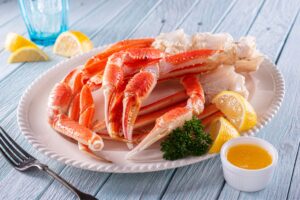When you see fish displayed on ice, assuming it was just caught might be tempting. But the truth is that the fillets you purchase at your local seafood counter are usually frozen and defrosted to stock the case.
This allows retailers to minimize waste and keep seafood in their freezers longer. Plus, it enables consumers to get the fish they want when it’s in season and affordable. For more fresh catch frozen seafood, check this out.
Freshness
 A seafood meal should be served as close to the source as possible. This is why seafood should be gutted, cleaned and immediately frozen (ideally on ice). When purchasing fresh-caught fish from the local fishmonger, look for bright eyes, firm flesh and red gills. Also, check that the skin is healthy and elastic and the smell is clean, not fishy or rancid.
A seafood meal should be served as close to the source as possible. This is why seafood should be gutted, cleaned and immediately frozen (ideally on ice). When purchasing fresh-caught fish from the local fishmonger, look for bright eyes, firm flesh and red gills. Also, check that the skin is healthy and elastic and the smell is clean, not fishy or rancid.
Seafood that has been flash frozen right after it’s caught is best since freezing stops the processes of spoilage immediately. It takes at least a week for fresh fish to travel from the sea to your supermarket’s refrigerator, during which time it can degrade significantly.
When buying frozen seafood, make sure it is individually packaged and has a label clearly showing the packaging date and contents. Look for sealed bags free of ice crystals and avoid open, torn or crushed packages. When it comes to shellfish, tap the shells to see if they close, and ensure that crabs and lobsters show some movement when you pick them up.
Quality
Seafood caught and frozen immediately after harvest retains its quality – a process known as flash freezing. The process locks in the fish’s flavour, texture and nutritional content so the seafood can be just as fresh when thawed.
The snap-freeze method also protects the nutrient content of seafood by quickly halting lipid degradation, microbial spoilage and other unwanted changes in the fish. The result is seafood high in omega-3 fatty acids, protein, and essential vitamins and minerals. For more fresh catch frozen seafood, check this out.
This makes frozen seafood a convenient and nutritious option for consumers who want to eat well without extensive meal planning or sacrificing taste and quality. And it benefits the environment as well. According to Ecotrust, a Portland-based nonprofit, 30 per cent of fresh seafood bought in grocery stores ends up in the trash, contributing to climate change and waste. The frozen alternative allows for the same seafood available in your local store but without relying on air freight and other environmentally damaging shipping methods.
Variety
The best-frozen seafood products are flash-frozen at the point of harvest, preserving the original microflora. This prevents the formation of spoilage organisms that cause off-flavours and odours, which can develop in fresh fish due to water temperature, method of capture, or transport and storage conditions.
Most of the seafood you buy at a supermarket has been frozen before it reaches the shelves, whether on ice or wrapped in plastic. The same is true of many online fish marketplaces that ship their product vacuum-sealed on dry ice to your door in a one-time order or on a recurring subscription.
Dietitian Lisa Young, RDN, recommends buying sustainable seafood from brands that offer detailed records of where and when their seafood was caught. These brands usually follow escapement quotas that ensure enough fish return to their native spawning grounds to maintain healthy populations. They may also use strict handling and packaging protocols to maintain quality. This includes freezing quickly and keeping the temperature consistent to preserve flavour, texture and shelf life.
Value
Seafood is a tasty and healthy food, but it can be expensive due to harvesting, processing, handling, transporting and storage costs. With advancements in freezing technologies and transportation logistics, frozen seafood has become a global trade, giving consumers access to high-quality seafood they may not have otherwise. For more fresh catch frozen seafood, check this out.
Seafood harvested from the wild is subject to quotas set by the government and dictates how many fish can be caught by country, vessel or company during a specific period. The availability of fresh catch seafood has led to overfishing, which can threaten the health of marine ecosystems, and there are concerns about labour practices within the seafood industry.
Frozen seafood allows the consumer to buy more at once and can also contribute to reducing food waste as it lasts longer than its fresh counterpart. Additionally, frozen seafood can be prepared just like its new counterparts and is readily available year-round.